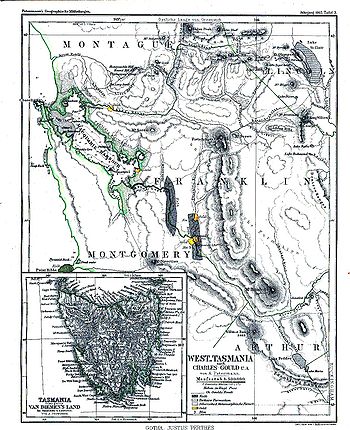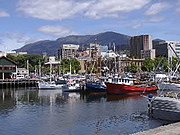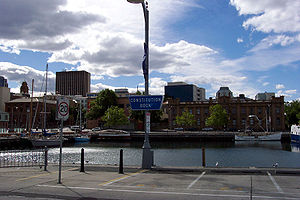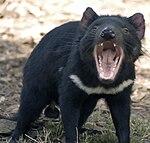User:Josh Petrass/Tasmania
Template:Australia state or territory
The island of Tasmania, is located 240 km south of the eastern side of the continent Australia, being separated from it by Bass Strait.[1] Tasmania has a population of 488 900 (end of June quarter 2006)[2] and an area of 67,800[1]. Tasmania promotes itself as the Natural State owing to its large, and relatively unspoilt, natural environment. 40% of Tasmania is formally in reserves, National Parks and World Heritage Sites.
The capital and largest city is Hobart, which also encompasses the cities of Glenorchy and Clarence. Other major population centres include Launceston in the north, and Devonport and Burnie in the northwest.
The subantarctic Macquarie Island is also under the administration of the state.
Climate
Tasmania is located at latitude 40° South, longitude 144° East, right in the pathway of the notorious "Roaring Forties" wind that encircles the globe. Tasmania has a climate rather like England.
The seasons are opposite to that of the Northern Hemisphere. Summer is from December to February when the average maximum temperature is 21 °C (70 °F). Winter is from June to August with an average maximum temperature of 12 °C (54 °F).
Highest maximum temperature: 40.8C (105.4F), Hobart, 4 January 1976
Lowest minimum temperature: -13.0C (8.6F), Shannon, 30 June 1983
The annual rainfall varies from 626 mm (25 inches) in Hobart to 2400 mm (94 inches) on the west coast. The prevailing weather pattern is from west to east and creates a rain shadow in the same direction. The weather on the east coast is nearly always warmer and drier than the rest of the state. Rainfall is evenly distributed throughout the year. Tasmania has four distinct seasons. Summer is warm with sunny days and mild evenings. Thunderstorms are normal in early summer. The weather is more stable between the months of February and April, from mid summer to late autumn. Autumn provides the classical transition to winter with very cool to frosty nights and clear cool days with deciduous trees displaying autumn colours and losing leaves. Winter is characterised by sudden storms, shorter daylight hours and snow on the higher peaks (Mt Ossa 1,617 m / 5300 ft the highest ).
All these factors contribute to the extremely diverse Tasmanian vegetation, from tall evergreen eucalypt forest, alpine heathlands and large areas of cool temperate rainforests and moorlands. Many flora species are unique to Tasmania, and some are related to species in South America and New Zealand through ancestors which grew on the super continent of Gondwanaland, 50 million years ago.
Prehistory
Between 25,000 and 40,000 years ago it is likely that humans arrived in Tasmania. Tasmanian Aboriginals lived farther southward than any other people at about 20,000 years ago. In caves in the southwestern part of the island images have been dated at about 14,000 years. Bass Strait as a land bridge appears to have been closed off about 12,000 to 13,000 years ago.
Main article: Tasmanian Aborigines
Government
The form of the government of Tasmania is prescribed in its Constitution, which dates from 1856, although it has been amended many times since then.
Since 1901 Tasmania has been a state of the Commonwealth of Australia, and the Australian Constitution regulates its relationship with the Commonwealth, and prescribes which powers each level of government has.
Politics
Tasmania has a number of relatively unspoilt, ecologically valuable regions. Proposals for local economic development have therefore been faced with strong requirements for environmental sensitivity, or outright opposition. In particular, proposals for hydroelectric power generation proved controversial in the late 20th century. In the 1970s, opposition to the construction of the Lake Pedder impoundment led to the formation of the world's first green party, the United Tasmania Group. In the early 1980s the state was again plunged into often bitter debate over the proposed Franklin River Dam. The anti-dam sentiment was shared by many Australians outside Tasmania, and proved a factor in the election of the Hawke Labor government in 1983, which halted construction of the dam. Since the 1980s the environmental focus has shifted to old growth logging, which has proved a highly divisive issue. The Tasmania Together process recommended an end to clear felling in high conservation old growth forests by January 2003.
In the Commonwealth Parliament, Tasmania is well represented in the Senate, where seats are not proportional to population. Between 1975 and 2005, Tasmanian independent senator Brian Harradine often held the balance of power. As a result he was able to gain the passage of legislation that, although often matching his conservative religious views, was also very financially rewarding for the state. Harradine successfully defended his seat in six consecutive senate elections and did not stand for re-election at the 2004 federal election. His term ended in June 2005.
Tasmania's House of Assembly and local government elections use a system of multi-seat proportional representation known as Hare-Clark.
In the 2002 state election, the Labor Party held 14 of the 25 available seats. The Liberal Party saw their percentage of the vote decrease dramatically, claiming only 7 seats. The Greens won four seats, with over 18% of the vote, the highest proportion of any Green party in any parliament in the world.
On 23 February 2004, the Premier Jim Bacon announced his retirement, due to being diagnosed with lung cancer. He died four months later.
Bacon was succeeded by Paul Lennon, who, after leading the state for two years, went on to win the 2006 state election in his own right.

Economy
Tasmania's erratic economy was first experienced by colonists in the early 1800s. The reasons have been many and varied over the years. More recently the reasons have been attributed to: lack of federal infrastructure highway, lack of a gold rush, lack of open immigration initiatives, lack of population, decline in the wool and mineral economies, lack of early colonial initiatives, or lack of foreign investment. For the length of the history of Tasmania there has been a continuing exodus of youth to mainland Australia in order to seek employment opportunities.
Traditionally Tasmania's main industries have been: mining, including copper, zinc, tin, and iron; agriculture; forestry; and tourism. Significantly in the 1940s and 1950s there had been a notion of 'Hydro-Industrialisation' embodied in the state by Hydro Tasmania. These all have had varying fortunes over the last century and more, involved in ebbs and flows of population moving in and away dependent upon the specific requirements of the dominant industries of the time.
There had been a decline in manufacturing during the 1990s, leading to a drain of some of the island's trained and experienced working population to mainland Australia. The major urban centres such as Melbourne and Sydney are popular destinations.
The state has a large number of food exporting sectors, including seafood (for example, Atlantic salmon, abalone and crayfish).
Since 2001, Tasmania has experienced a positive turnaround. Favourable economic conditions throughout Australia, cheaper air fares and three new Spirit of Tasmania ferries have all contributed to what is now a booming tourism industry. Record numbers of tourists are discovering the island, the property market is booming and the growth of businesses is now being limited by labour constraints.
Today, a significant number of employed Tasmanians work for the government. Other major employers include the Federal Group, owner of several hotels and Tasmania's two casinos, and Gunns Limited, the state's biggest forestry company. In the late 1990s, many national companies based their call centres in the state after obtaining cheap access to broad-band fibre-optic connections.
Apparently the state's housing market was undervalued in the early part of 2000, and a large boom in the national housing market finally made Tasmanian housing prices rise dramatically. This has in part been attributed to increased levels of interstate[3] and overseas migration. A shortage of rental accommodation has caused problems for many of Tasmania's low income earners.
Small business is a large part of the community life and it is believed by many that the business environment in Tasmania is not an easy one to survive in. However there have been many success stories, such as International Catamarans, Moorilla Estate and Tassal.
Transport
The fastest and cheapest method of travel across Bass Strait is by air. The main carriers are Qantas and its subsidiary JetStar, and Virgin Blue, which fly direct routes to Melbourne, Sydney, Brisbane, and Adelaide. Major airports include the Hobart International Airport and Launceston Airport; the smaller airports, Burnie and Devonport, are serviced by Regional Express and Qantaslink, which generally fly only to Melbourne and the Bass Strait islands.
The domestic sea route is being serviced by the Bass Strait passenger/vehicle ferries operated by the Tasmanian Government-owned TT-Line (Tasmania). From 1986 the Abel Tasman made six weekly overnight crossings between Devonport and Melbourne. It was replaced by the Spirit of Tasmania in 1993, which performed the same route and schedule. The most recent change was the 2002 replacement of the Spirit by two Superfast ferries - Spirit of Tasmania I and Spirit of Tasmania II — which brought the number of overnight crossings up to fourteen, plus additional daylight crossings in peak times. In January 2004 a third ship, the slightly smaller Spirit of Tasmania III, started the Devonport to Sydney route. This service was axed by the Tasmanian Government in June 2006 due to low passenger numbers. Two container ships owned by Toll Shipping also make daily crossings between Burnie and Melbourne. The port of Hobart also serves as a host to visiting cruise ships and before the September 11, 2001 attacks was a regular port of call for United States Navy ships returning home from the Indian Ocean and Persian Gulf.
The state is also home to International Catamarans, a manufacturer of very high-speed aluminium vessels (commonly known as SeaCat) that broke records regularly when they were first launched. The state Government tried using them on the Bass Strait run, but eventually the decision was made to discontinue the run due to concerns over viability and the suitability of the vessels to the sometimes extreme weather conditions experienced in Bass Strait.
Tasmania, Hobart in particular, serves as Australia's chief sea link to the Antarctic and south Pacific Ocean, with the Australian Antarctic Division located in Kingston. Hobart is also the home port of the French ship l'Astrolabe which makes regular supply runs to the French Southern Territories near and in Antarctica.
Hobart also has the second deepest natural port in the world, second to only Rio de Janeiro in Brazil.
Within the state, the primary form of transport is by road. Since the 1980s, many of the state's highways have undergone regular upgrades. These include the Hobart Southern Outlet, Launceston Southern Outlet, Bass Highway re-construction, and the Huon Highway.
Rail transport in Tasmania consists of narrow gauge lines to all four major population centres and to mining or forestry operations on the west coast and in the northwest. Services are operated by TasRail, a Pacific National subsidiary. Regular passenger train services in the state ceased in 1977; the only trains are for freight, and there are tourist trains in specific areas. In 2005 there were concerns that the rail service was in so much trouble that it might stop for everything but cement haulage.
The West Coast Wilderness Railway is a good example of a recently rebuilt tourism-specific railway (2002).
Culture
Sport
The dominant sports in Tasmania are cricket and Australian rules football. The Tasmanian Tigers cricket team, which plays home games at Bellerive Oval on the eastern shore of the Derwent River, Hobart, represents the state in limited overs and first-class cricket competitions. Tasmania has produced two international cricket stars, David Boon and current Australian captain Ricky Ponting. However in the last few years Tasmanian cricketing quality has increased with them winning the ING One Day Cup in 2004/05 for the first time in 10 years.
Despite Australian rules football's huge popularity in the state, Tasmania does not have a team in the Australian Football League. They do have a team (the Tasmanian Devils) in the VFL (Victorian league), and a team in the national league is a popular topic among supporters as well as the state government (one of the potential sponsors of such a team). Some AFL teams play scheduled games at Aurora Stadium (at York Park in Launceston). These teams include Hawthorn and St Kilda who substitute their home games in Melbourne for games at Aurora Stadium to create extra revenue for the clubs. They generally play 2-3 games a year per team. The AFL continues to consider expanding into Tasmania.
In basketball, the state is not represented in the National Basketball League, although strong representation from the state can be found in the South East Australian Basketball League. Two men's teams: The Oasis Hobart Chargers, and the Northwest Tasmania Thunder are joined in the women's SEABL by the Launceston Tornadoes and the Women's NW Tasmania Thunder also.
Tasmania's small population and low sponsorship potential results in the state not being represented in national football (soccer) (see Football (soccer) in Tasmania) and netball leagues.
Events
In order to foster tourism, the state government encourages or supports several different annual events in and around the island. The best known of these would be the Sydney to Hobart Yacht Race [1], starting on Boxing Day in Sydney and usually arriving at Constitution Dock in Hobart around three to four days later, during the Hobart Summer Festival [2].
The Targa Tasmania road rally [3], usually held in late April or early May, attracts world-class rally drivers and is staged all over the state, over five days.
Skyrace Tasmania (now defunct), an airshow & Pylon Racing aviation event was held annually throughout the mid 1990s at Valleyfield, an old WW2 airstrip south of Launceston.
Agfest [4] is a three-day agricultural show held at Carrick (just west of Launceston) in early May, and despite its agricultural focus it attracts city and country residents – 75000 people in 2004. Other major shows include the Royal Hobart Show and Royal Launceston Show, held in October of each year.
A recent addition to the state has been the 10 Days on the Island arts festival; however, it has drawn criticism from environmental groups for its acceptance of sponsorship from forestry company Gunns.
The Basin Concert (now defunct) was a music concert held at the Cataract Gorge in Launceston. Current festivals include Gone South [5], held four times since 1999, and the Falls Festival [6], a Victoria event now held in both Victoria and Tasmania on New Year's Eve.
The Antarctic Midwinter Festival [7] celebrates Hobart's special connection with the Antarctic, on the winter solstice in June each year.
Taste of Tasmania is an annual food and wine festival centred around the Hobart foreshore on and around New Year.
Prominent Tasmanians
Tasmania has produced a number of significant people. These include: the actor Errol Flynn, Crown Princess Mary of Denmark (Mary Donaldson), Australian cricket personalities Ricky Ponting and David Boon.
Indigenous animals
Thylacine
The island of Tasmania was home to the Thylacine, a marsupial which resembles a wild dog. Known colloquially as the Tasmanian Tiger for the distinctive striping across its back, it became extinct in mainland Australia much earlier because of the introduction of the dingo. Owing to persecution by farmers, government-funded bounty hunters, canine distemper, and, in the final years, collectors for overseas museums, it also appears to have been exterminated in Tasmania. The last known animal died in captivity in 1936. Many alleged sightings have been recorded, none of them confirmed.
Tasmanian Devil
The Tasmanian Devil is a carnivorous marsupial found exclusively on the island of Tasmania.
The size of a small dog but stocky and muscular, the Tasmanian Devil is characterised by its black fur with white patches. It has an offensive odour when stressed, performs a loud and disturbing screeching, and possesses a vicious temperament. The Devil survived European settlement and was considered widespread and fairly common throughout Tasmania until recently.
Like a lot of the wildlife, fast vehicles on the roads cause problems for the Tasmanian Devil.
As of 2005 the Tasmanian Devil population has been reduced by about 90% in some areas of Tasmania by Devil facial tumour disease. It is believed the majority have starved when the tumours have spread to their mouths and that the tumours spread by fighting between devils – typically, fighting devils will bite one another's faces. There is no cure for the disease, and intensive research is under way to determine its cause. There are also breeding programs undertaken in wildlife parks to secure a disease-free population of Tasmanian Devils.
Birds
Many birds of the Australian mainland and Southern Ocean also occur in Tasmania. Tasmania has 12 endemic bird species: 4 honeyeaters (family Melaphagidae) - the yellow wattlebird (world's largest honeyeater) and the yellow-throated, black-headed and strong-billed honeyeaters; 3 Australo-Papuan warblers (family Acanthizidae) - the Tasmanian thornbill, the scrubtit and the Tasmanian scrubwren; 1 pardalote (family Pardalotidae) - the rare and endangered forty-spotted pardalote; 1 old-world flycatcher (family Muscicapidae) - the dusky robin; 1 corvid (family Corvidae) - the black currawong; 1 parrot (family Psittacidae) - the green rosella; and 1 rail (family Rallidae) - the Tasmanian native hen, Australia's only flightless bird other than the giant ratites (emu and southern cassowary). The endemic Tasmanian Emu was exterminated in the mid-1800s.
Frogs
Tasmania is home to 11 species of frogs. Three of these are only found in Tasmania, the Tasmanian Tree Frog (Litoria burrowsae), the Tasmanian Froglet (Crinia tasmaniensis) and the only recently discovered Moss Froglet (Bryobatrachus nimbus). Of the 11 species that inhabit Tasmania all are native to Australia. Tasmania is home to the largest breeding population of Growling Grass Frogs (Litoria raniformis), a vulnerable species, which has declined over much of its range.
Places in Tasmania

|
Islands:
Lakes: |
Significant bridges: Beaches: |
Main highways: |
Rivers: |
Mountains:
Regions: |
See also: List of Australian islands, lakes, bridges, highways, rivers, mountains and regions.
See also
- Protected areas of Tasmania
- University of Tasmania
- List of postcodes in Tasmania, Australia
- List of schools in Tasmania
- History of Tasmania
- Van Diemen's Land
References
- ↑ 1.0 1.1 "Tasmania." Encyclopædia Britannica. 2006. Encyclopædia Britannica Online. 8-12-2006
- ↑ 3101.0 - Australian Demographic Statistics, Jun 2006 ABS
- ↑ ABC Television News (Tasmania), 7 p.m. Friday, 27/1/06
External links
- - Where is Tasmania? web page
- Tasmania Online - the main State Government website
- Discover Tasmania - official tourism website
- Interactive Tour of Tasmania
- NASA Satellite image of Tasmania
- Another detailed map
- Wilderness and Wine Routes
- Wild, Blue and Free. Tasmanian online discovery TV series with fact sheets, photo galleries, video
- CoastView.com.au for information and webcams around Tasmania [8]




